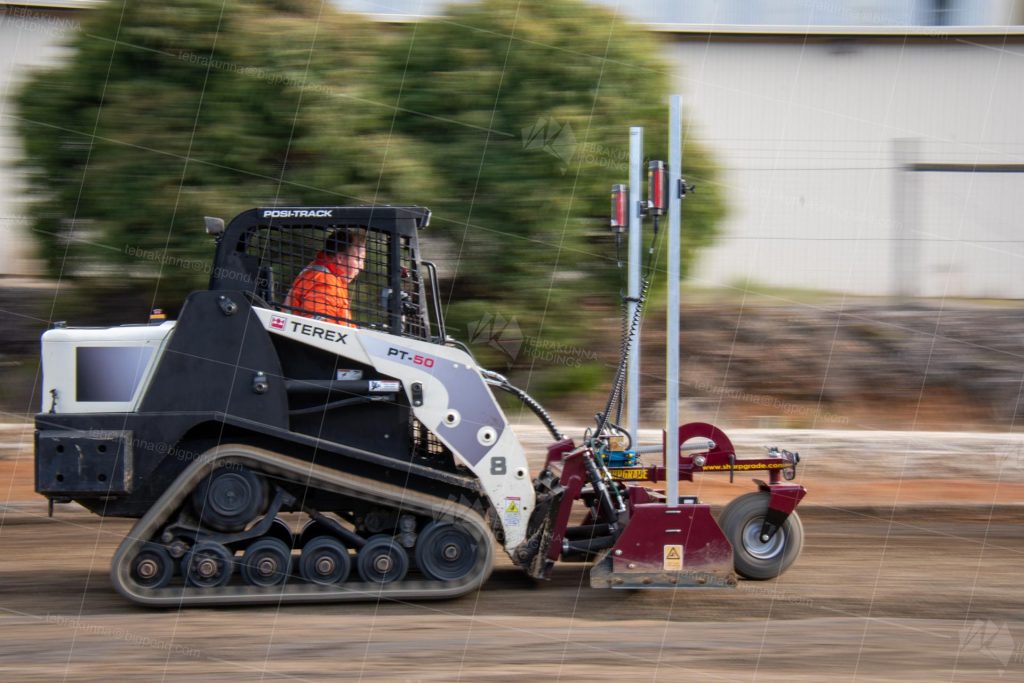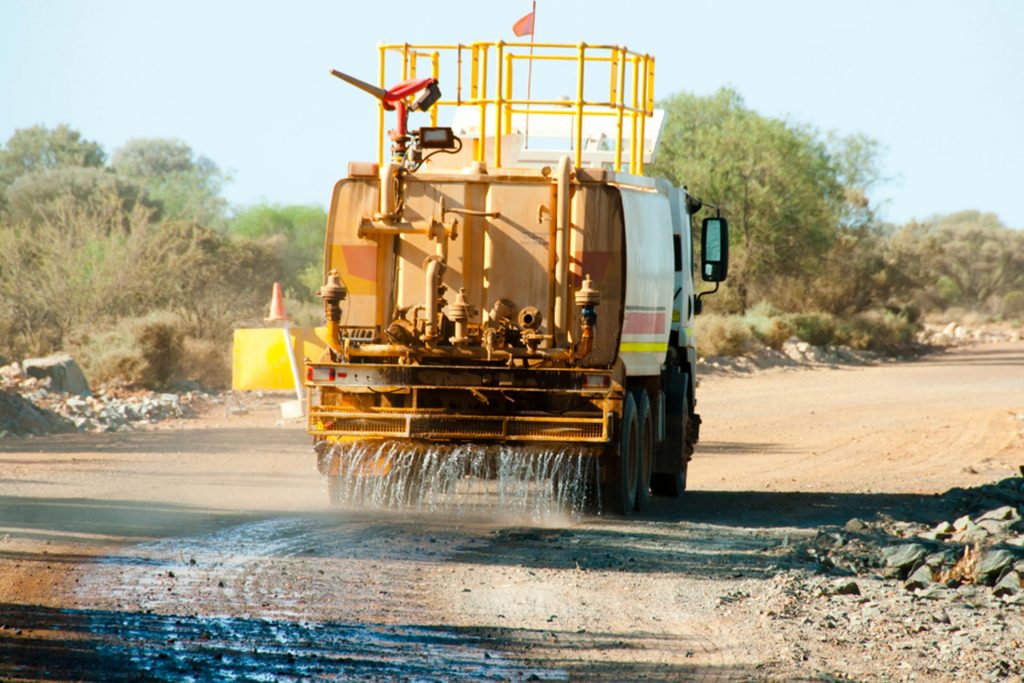In July 2022, a worker died after being hit by a moving water truck. The man was part of a crew working on a development road. Early investigations indicate he was struck when the water truck was reversing.
In June 2022, a skid steer loader was spreading gravel onto a residential driveway when for reasons yet to be established, it struck and killed a person who was close by.

Investigations are ongoing.
Safety issues
Typical hazards found in managing risks of mobile plant, including water trucks and skid steer loaders, can include:
- traffic movements of the mobile plant
- powered mobile plant moving in and around a workplace (reversing, loading and unloading) are a potential danger for workers and members of the public
- the environment in which the mobile plant is used
- the plant itself.
Mobile plant can pose potential serious risks to operators or other people nearby, including:
- the plant colliding or contacting people or objects such as other vehicles or plant and energised powerlines
- the plant moving in an uncontrolled or unexpected manner
- the plant overturning
- objects falling on the operator
- the operator being ejected from the plant
- mechanical or other failures (hydraulic failures, release of hazardous substances).
Operators of mobile plant can often have severely restricted visibility of ground workers or nearby pedestrians, particularly those close to the plant around blind spots.

Ways to manage health and safety
Taking steps to manage risks is a condition of doing business in Queensland. Effective risk management starts with a commitment to health and safety from those who manage the business. If an incident occurs, you’ll need to show the regulator that you’ve used an effective risk management process. This responsibility is covered by your primary duty of care in the Work Health and Safety Act 2011.
Use the hierarchy of controls to help decide how to eliminate and reduce risks in your place of work. The hierarchy of controls ranks types of control methods from the highest level of protection and reliability to the lowest. It’s a step-by-step approach to eliminating or reducing risks. You must work through the hierarchy of controls when managing risks, with the aim of eliminating the hazard, which is the most effective control.
Possible control measures to prevent similar incidents
Employers and self-employed persons are required to control the risks associated with mobile plant, including the risk of pedestrians being struck by plant such as water trucks and skid steer loaders. Before operating any piece of mobile plant, the person with management or control of it must ensure:
- the plant selected for the work is:
- suitable for the task
- fitted with appropriate safety features (rear-view mirrors and warning devices, including audible horn and reversing alarm)
- maintained in a safe condition, including roadworthy for road registered vehicles
- the design and implementation of a traffic management plan, including identifying suitable exclusion zones and communicating these to workers and other persons in the vicinity before tasks are carries out
- demarcation of the exclusion zone to warn nearby workers or pedestrians, including across public footpaths where work is being carried out (using temporary guardrail or fencing and signage)
- the use of a spotter where required, including suitable means of communication between the spotter and operator (using two-way radio) to assist with the safe movement of the plant, particularly where there may be blind spots or other workers or people in the vicinity
- ground conditions and the intended travel pathway have been inspected and assessed to identify any problem areas (sloping ground or soft/uncompacted ground)
- there is adequate lighting to safely operate the plant
- if outdoors, adverse weather conditions, including reduced visibility, have been considered
- any workers around the plant are aware of operator blind spots and exclusion zones
- the person with management or control of the mobile plant must ensure it has a warning device to alert people who may be at risk from the movement of the plant. There are a number of warning devices that can be fitted to mobile plant to alert the operator and others in the workplace including:
- automatic audible alarms which are usually fitted to warn of forward or reversing movement. These alarms emit an intermittent sound which is activated when the gear or drive lever is engaged. The sound should be distinct and clearly audible only in the hazard area.
- motion sensors are used to activate an integrated or separately located alarm. Motion sensors also warn with sound. They are sensitive to movement and are activated by motion in the required direction. These devices are suitable for plant that move suddenly in any direction, for example rollers, bulldozers, excavators, boom lifts or scissor lifts.
- lights are usually used to warn of forward and reversing movement. These lights are wired to operate continuously or in hazard mode by flashing, usually when reversing. They generally work when the gear or drive lever is engaged. It is important to choose the intensity and colour of lights appropriate to your workplace to ensure the moving plant can be seen.
- radio sensing devices activate when the operator selects reverse. A light and alarm sound inside the cabin to alert the operator if a pedestrian is within a predetermined distance from the rear of the plant.
- the manufacturer’s operating instructions have been read and are followed
- untrained or inexperienced workers should not operate the plant, particularly in unfamiliar or high-risk terrain or for unfamiliar tasks
- relevant information, training, instruction and supervision necessary to control the risks associated with the plant is provided
- training programs should be practical and ‘hands on’ and take into account particular needs of workers like literacy levels, work experience and specific skills required for safe use of the plant
- ensuring worker training, experience and competency aligns with the requirements and complexity of the task
- workers who drive road registered vehicles hold the appropriate type of license to drive that vehicle, irrespective of whether the vehicle is operated on a public road, worksites or private property
- workers who operate vehicles, other than road registrable vehicles, are provided with familiarisation training on the specific make and model of vehicle
- familiarisation training and competency assessment on the particular make and model of the plant should be documented.
Business owners must first consider controls that most effectively eliminate the risk or, where not reasonably practicable, that minimise the risks. Hazards such as pedestrians being struck by mobile plant may also be minimised by implementing administrative controls, so far as is reasonably practicable. Administrative controls can include the design and implementation of a traffic management plan.
Traffic management plan
A traffic management plan is a set of rules for managing the movement of traffic in your workplace. It should be developed by the business owner/contractor in consultation with workers and others in the workplace. Everyone affected by the plan must understand it and follow it.
An effective traffic management plan will include broad types of control measures that aim to do the following things:
- keep mobile plant and people apart
- limit plant movements or speed
- avoid the need for reversing plant
- provide a safe area for the driver
- make sure signage road/area markings are clear
- ensure effective workplace communication.
Adapted from Safe Work Australia guidance material
The best way to protect pedestrians is to stop people and mobile plant cannot interacting directly. This can be done by not allowing mobile plant into pedestrian spaces or restricting pedestrians from entering mobile plant operating areas.
However, this may not always be reasonably practicable, and where people and mobile plant cannot be separated, consider the following:
- barriers or guardrails at building entrances and exits to stop pedestrians walking in front of mobile plant
- high impact traffic control barriers
- temporary physical barriers
- separate, clearly marked footpaths or walkways (using lines painted on the ground or different coloured surfacing)
- pedestrian routes and intersections should be clearly marked, unobstructed, well maintained and well lit
- supervision of the exclusion area and good communication between the supervisor and plant operator ensures access to exclusion zones is limited to authorised personnel
- cameras may be fitted to allow operators to see in the plant’s ‘blind spots’ (areas usually obstructed or unable to be seen from the operator’s perspective)
- use of spotters.
Any remaining risk must be minimised with suitable personal protective equipment. For example:
- use hard hats, steel cap boots, eye protection, hearing protection and high visibility vests
- safety footwear should be:
- suitable for the type of work and environment
- comfortable with an adequate non-slip sole and appropriate tread
- checked regularly to ensure treads are not worn away or clogged with contaminants.
Administrative control measures and PPE rely on human behaviour and supervision. If used on their own, they are least effective in minimising risks. The control measures you put in place should be reviewed regularly to make sure they work as planned.

